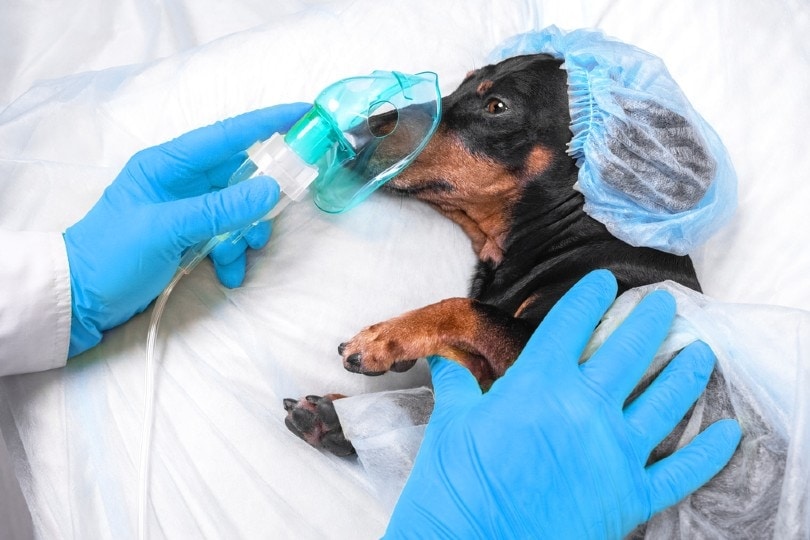Can Dogs Take Zofran? Our Vet Explain Uses, Risks & FAQ

Updated on

Click to Skip Ahead
Zofran is the brand name for the medication ondansetron. Ondansetron is a drug that is used to prevent nausea and vomiting caused by surgery, cancer chemotherapy, and radiation therapy in humans. It belongs to a class of drugs called antiemetics and comes in many different formations.
It can be used to treat severe cases of vomiting in dogs and cats, but the use of Zofran in dogs and cats is classed as “off-label.” This means that it is being used for a medical condition or disease that it is not officially approved to treat. In veterinary medicine, many drugs are prescribed for off-label use. In these circumstances, you must follow your vet’s instructions as they may differ from the instructions on the product label.
What Is Zofran?
Zofran is an antiemetic that works by blocking the action of serotonin. Serotonin is a chemical compound in the body that can trigger vomiting and nausea. Serotonin targets specific receptors called 5-HT3 receptors. They are situated in the brain and the digestive tract. When these receptors are blocked, vomiting and nausea signals are prevented from being sent to the vomiting center of the brain.
Zofran is usually given to dogs when other antiemetics have failed to control severe vomiting or if veterinary patients cannot tolerate regular antiemetics that are normally prescribed.
Zofran should be stored at room temperature, which is ideally between 68 and 77°F.
Tablets should be kept in their original container and should be kept away from direct sunlight and any moisture. Avoid storing in humid places such as bathrooms.
The oral solution should be discarded after 28 days of being open even if all of the product hasn’t been used. Zofran should always be kept out of the reach of children and pets.

How Is Zofran Given?
Zofran is available in a few different forms. There are standard tablets, tablets that melt on the tongue, an oral solution, and an injectable form.
The recommended dose is 0.5 mg/kg orally or intravenously every 12–24 hours or 30 minutes before chemotherapy is given. In some circumstances, higher doses of up to 1 mg/kg can be used. Your vet will be able to calculate a dose for your dog based on their weight and the clinical circumstances. The drug can be given with or without food. It is usually well absorbed even if your dog has recently eaten.
When being used to prevent nausea and vomiting related to chemotherapy treatment, it is usually given on an empty stomach 30 minutes before the chemotherapy. If it is being used for motion sickness, tablets can be given with or without food 30 minutes to an hour before the car journey.
What Happens if You Miss a Dose?
Missing a dose of Zofran generally isn’t a huge cause for concern. If you miss a dose of Zofran, give it as soon as you remember.
If it is close to your dog’s next scheduled dose, it is usually advised to skip the missed dose and then continue with the dosing schedule your vet has prescribed. If there is still a long time until your dog’s next scheduled dose, it is acceptable to give the missed dose as soon as you remember. This is especially important if your dog is relying on the drug to control severe clinical signs.
Do not give double doses to your dog, or any extra doses that haven’t been prescribed by your vet.

Potential Side Effects of Zofran
Zofran is generally considered safe for dogs if used appropriately, under veterinary instruction. However, just like all drugs, it can cause potential side effects.
- Constipation
This is the most frequent side effect seen with Zofran. Increasing water intake and feeding foods with a high fiber content can help with the movement of feces.
- Lethargy/Drowsiness
Some owners note their dogs appear less active and sleep more when taking Zofran. This is more often seen with higher doses of the drug.
- Loss of Appetite
Some owners report their dog goes off their food. It is usually a temporary occurrence, and their normal appetite resumes quickly. Smaller, more frequent portions of their favorite food can help to encourage them to eat. If a dog is off their food for prolonged periods, this may not be a side effect of the drug so will need further investigation by your vet.
- Diarrhea
Confusingly, this is the opposite of the most common clinical sign of constipation that is reported. Some dogs experience diarrhea or loose stools. If diarrhea occurs it is best to contact your vet as there may be another cause.
- Headaches
Dogs cannot tell their owners they have a headache, however, there can be some subtle signs they are experiencing head pain. They may shake their heads, paw at their heads, or press themselves against a hard object. Speak to your vet immediately if you see any of these clinical signs.
- Allergic Reactions
Although rare, some dogs may experience signs of an allergic reaction. They may develop a skin rash, start to itch, swell in certain areas, or have difficulty breathing.
- Abnormal Heart Rhythms
Arrhythmias can occur, but they are more likely to happen in dogs with pre-existing heart conditions.
- Seizure Activity
This is a rare side effect, but a serious one that requires immediate veterinary attention.
Frequently Asked Questions
How long does it take for Zofran to start working in dogs?
Zofran starts to work relatively quickly in dogs. It typically takes 30 minutes for the drug to start to take effect. It can then take a few hours for the full effect to be experienced.

When is Zofran contraindicated in dogs?
- If your dog has an intestinal blockage
- If they have liver or kidney disease
- If they are allergic to Zofran
- If they have a heart condition
- If they are already on certain medications such as tramadol or some heart disease drugs
Zofran is not indicated for long-term use due to the risk of side effects.
What should I do if my dog experiences side effects from Zofran?
If you see any clinical signs of potential side effects in your dog after they have received Zofran, it is important to take your dog to your vet straight away. Your vet will be able to assess your dog, administer appropriate treatment, and stop the medication or adjust the dosage if required.
Conclusion
Zofran is an antiemetic drug that can be used to control vomiting in a variety of different conditions. It is most often used to control vomiting caused by chemotherapy drugs treating cancer patients.
It is a useful drug but there are some side effects reported. If you think your dog is experiencing side effects while taking Zofran, get in contact with your vet immediately.
Your vet will discuss any risks or concerns with you before starting the drug. They will be able to prescribe an appropriate dose for your dog. Zofran must only be used under veterinary direction.
Featured Image Credit: Jus_Ol, Shutterstock















